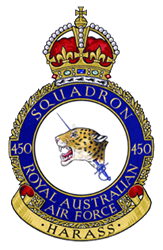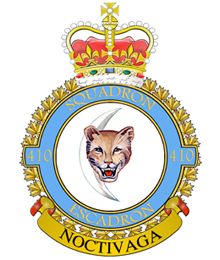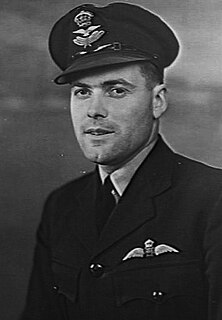
No. 460 Squadron is a Royal Australian Air Force intelligence unit active within the Defence Imagery and Geospatial Organisation (DIGO). It was first formed as a heavy bomber squadron during World War II on 15 November 1941 and disbanded on 10 October 1945 after seeing extensive combat over Europe. The squadron was a multinational unit, but most personnel were Australian. No. 460 Squadron was reformed on 2 July 2010 and is currently located in Canberra.

No. 450 Squadron was a unit of the Royal Australian Air Force (RAAF) that operated during World War II. Established at RAAF Station Williamtown, New South Wales, in February 1941, it was the first Australian Article XV squadron formed under the Empire Air Training Scheme.
No. 462 Squadron is a Royal Australian Air Force (RAAF) squadron which forms part of the Information Warfare Directorate in the RAAF's Air Warfare Centre. The squadron was first formed in 1942 as a heavy bomber unit and saw combat in this role in the Mediterranean area until it was disbanded in March 1944. It was reformed in the United Kingdom in August 1944 to participate in the bombing campaign against Germany, and in December that year converted to a specialist electronic warfare unit. No. 462 Squadron continued in this role until the end of the European war in May 1945 and was disbanded in September that year. The squadron was reformed in its current role during April 2005.

No. 463 Squadron RAAF was a Royal Australian Air Force heavy bomber squadron during World War II. The squadron was formed in the United Kingdom in late 1943 from personnel and aircraft allocated from No. 467 Squadron RAAF. The squadron was equipped with Avro Lancaster bombers and flew its first raids on Germany immediately after being formed. Operating as part of RAF Bomber Command No. 463 Squadron conducted raids against cities, industrial facilities and military targets in Germany, France and Norway throughout 1944 and until the end of the war in May 1945. Following the war, the squadron evacuated Allied prisoners of war from Europe until it was disbanded in late 1945.

No. 467 Squadron RAAF was a Royal Australian Air Force bomber squadron, active over North West Europe during World War II. Formed in November 1942 as an Article XV Squadron in Britain, the squadron was notionally an Australian squadron under the command of the Royal Air Force, and consisted of a mixture of personnel from various Commonwealth nations. After becoming operational in early 1943, the squadron flew operations in Occupied Europe until the end of the war flying Avro Lancaster heavy bombers. It was scheduled to deploy to the Far East to take part in further operations against Japan, but the war ended before it could complete its training and the squadron was disbanded in September 1945.
Royal Air Force Andreas or more simply RAF Andreas is a former Royal Air Force station in the Isle of Man which was operational between 1941 and 1946. It was built in fields between Andreas and Bride in the north of the island. As was common practice, the station was named after the parish in which it was situated.
Flight Lieutenant Wallace McIntosh DFC & Bar, DFM flew 55 bombing missions with the RAF during the Second World War as a rear gunner in Lancaster bombers. McIntosh was regarded as the most successful air gunner in Bomber Command during the Second World War, and was credited with shooting down eight enemy aircraft.

410 Tactical Fighter Operational Training Squadron, nicknamed the "Cougars", is a Royal Canadian Air Force aircraft squadron currently located at Canada's primary training base for the CF-18, at Cold Lake, Alberta. The squadron was formed during the Second World War as an RCAF squadron under the Royal Air Force (RAF), at RAF Ayr, near Prestwick, in Scotland.
Squadron Leader Henry Melvin "Dinghy" Young, was a bomber pilot in the Royal Air Force Volunteer Reserve during the Second World War.

Roberts Christian "Bob" Dunstan DSO was an Australian soldier and aviator during the Second World War. He was notable, among other things, for:
Werner Baake was a night fighter pilot fighter ace and recipient of the Knight's Cross of the Iron Cross who served in the Nazi German Luftwaffe during World War II. The Knight's Cross of the Iron Cross was awarded to recognize extreme battlefield bravery or successful military leadership. Baake claimed 41 nocturnal aerial victories in 195 combat missions. He was the 36th most successful night fighter ace of World War II, and of aerial warfare. Baake's total surpassed that of all Allied night fighter pilots; Branse Burbridge being the highest.
Wing Commander Edward Chatham Wolfe was a famed World War II Royal Air Force fighter pilot who flew during the Battle of Britain.

John Raeburn Balmer, was a senior officer and bomber pilot in the Royal Australian Air Force (RAAF). Born in Bendigo, Victoria, he studied law before joining the RAAF as an air cadet in 1932. An instructor at Point Cook from 1935 to 1937, he achieved renown in Air Force circles when he reportedly parachuted from a training aircraft to motivate his pupil to land single-handedly. He also became known to the general public as a cross-country motorist, setting records for trans-Australia and round-Australia trips before World War II.

William Lloyd Brill, & Bar was a senior officer and bomber pilot in the Royal Australian Air Force (RAAF). Born in the Riverina district of New South Wales, he was a farmer and a member of the Militia before joining the RAAF in 1940. After training in Australia and Canada, he was posted to Britain in 1941 to take part in the air war over Europe. Brill first saw combat with No. 460 Squadron RAAF, flying Vickers Wellington medium bombers. He was awarded the Distinguished Flying Cross (DFC) in May 1942 for attacking a target after his plane was badly damaged by anti-aircraft fire. Following assignment as an instructor with the Royal Air Force (RAF), he returned to the bombing campaign in January 1944 as a flight commander with No. 463 Squadron RAAF, flying Avro Lancaster heavy bombers.

Keith MacDermott Hampshire, was a pilot and ace of the Royal Australian Air Force (RAAF) during the Second World War. He saw action in twin-engine propeller-driven aircraft, flying intruder, ground attack and night fighter missions.

David John Shannon, DSO & Bar, DFC & Bar was an Australian bomber pilot of World War II, known for his part in the "Dambusters" raid on the night of 16/17 May 1943. Born in South Australia, Shannon joined the Royal Australian Air Force (RAAF) in 1941 and learned to fly under the Empire Air Training Scheme. After further training in the United Kingdom he was posted to No. 106 Squadron RAF, operating Avro Lancaster heavy bombers, and was awarded the Distinguished Flying Cross (DFC) in January 1943.

John Verdun Newton was an Australian politician and Royal Australian Air Force (RAAF) officer. While serving with the RAAF in Europe during the Second World War, Newton was elected to the Parliament of Western Australia for the seat of Greenough at the 1943 state election, but was killed in action 55 days later.

The aircrews of RAF Bomber Command during World War II operated a fleet of bomber aircraft carried strategic bombing operations from September 1939 to May 1945, on behalf of the Allied powers. The crews were men from the United Kingdom, other Commonwealth countries, and occupied Europe, especially Poland, France, Czechoslovakia and Norway, as well as other foreign volunteers. While the majority of Bomber Command personnel were members of the RAF, many belonged to other air forces – especially the Royal Canadian Air Force (RCAF), Royal Australian Air Force (RAAF) and Royal New Zealand Air Force (RNZAF). Under Article XV of the 1939 Air Training Agreement, squadrons belonging officially to the RCAF, RAAF, and RNZAF were formed, equipped and financed by the RAF, for service in Europe. While it was intended that RCAF, RAAF, and RNZAF personnel would serve only with their respective "Article XV squadrons", in practice many were posted to units of the RAF or other air forces. Likewise many RAF personnel served in Article XV squadrons.

The Avro Lancaster PA278 disappearance involved Avro Lancaster Mk.I PA278, "F for Freddie", operated by No. 103 Squadron RAF of Bomber Command just after the end of the Second World War.

Squadron Leader Daniel Trevor Bulmer "Danny" Everett, DFC and 2 Bars, was a leading Royal Air Force Bomber Command and Pathfinder Force pilot and bombing leader, decorated three times for gallantry before being killed in action.
















